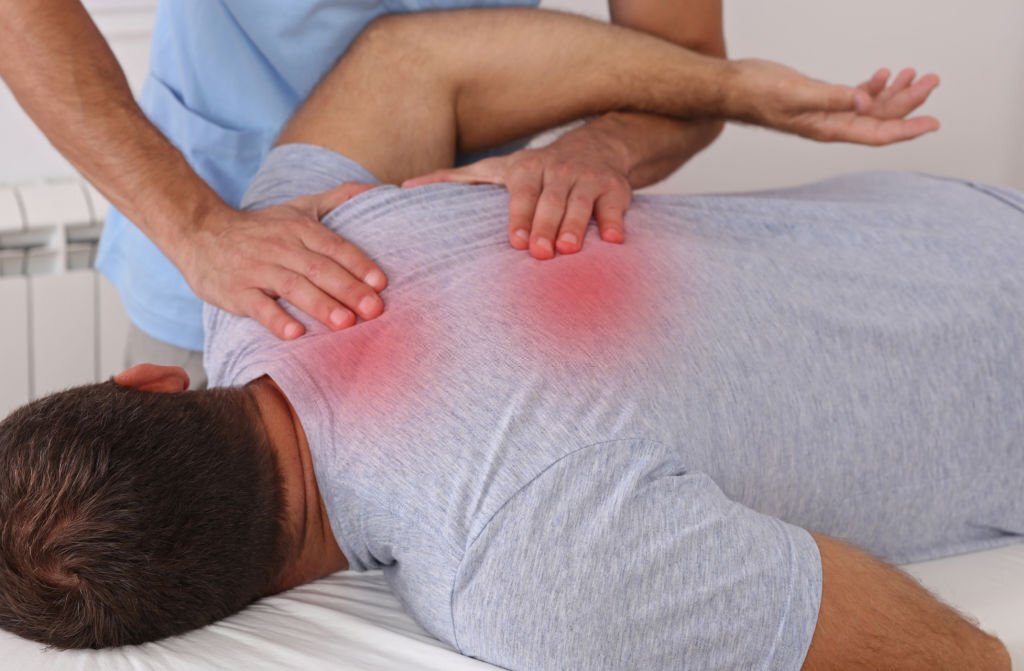
Upper Back Pain at Physio Horsham
Medically the area requiring upper back pain physiotherapy is known as the thoracic spine, which consists of a series of vertebrae, discs, muscles, and ligaments as well as rib articulations coming off the side of each of these thoracic vertebrae. Upper back pain can be as a result of stress or injury to any of these structures causing pain anywhere from the base of your neck to your rib cage.
Although perhaps not as common as low back pain or neck pain, complaints requiring upper back pain physiotherapy are still relatively common. In physiotherapy, ANRC Physiotherapy locations patients complaining of upper back pain is a regular occurrence because sedentary postures at the desk are a common cause of stiffness or tightness in thoracic structures.
Common Upper Back Pain Complaints Seen In Physiotherapy ANRC Physio Clinics
- Prolonged repetitive, forceful or awkward hand movements
- “Static loading” or holding a posture
- Poor conditioning of the heart and lungs, and poor muscle endurance
- Direct mechanical pressure on tissues
- Cold work environment
- Poorly fitting furniture
- Basic inadequacies of workstation design
- Work organizational and psychosocial issues
Similar to low back pain the thoracic spine can suffer from bulging and degenerative discs, pinched nerves, facet joint pain, muscle pain but as well as these other conditions requiring upper back pain physiotherapy can include:
Ankylosing spondylitis: Ankylosing spondylitis is a disease causing inflammation and pain in the spine and other joints such as the shoulder, hips, knees, ankles and between your sternum and ribs.
Scheuermann’s Disease: Scheuermann’s Disease is a developmental disorder of the spine causing the abnormal growth of the thoracic vertebrae.
Thoracic Spondylosis: Thoracic Spondylosis a common form of arthritis in the spine and is one of the most common causes of upper back pain and stiffness once aged over fifty.
Side Strain: Side strains also commonly cause thoracic region pain and are strongly related to fast bowlers in cricket, specifically related to bowling speed with the fastest bowlers much more likely to suffer this type of injury.
High-Risk Groups
- Computer users
- Checkout clerks
- Musicians
- Hairdressers
- Health professionals: surgeons, dentists
- Nurses
- Butchers
- Massage therapists
- Sportspersons
- Laboratory workers
- Children
- Teachers
- Housewives
- Manual labourers
- Assembly line workers
- Assistants
Upper back pain management at physiotherapy physio East Grinstead practices key aim is to restore normal function and improve any required strength and mobility in the thoracic spine and related areas. Upper back pain physiotherapy following assessment and diagnosis will use a combination of techniques to achieve the above goals. As previously stated upper back pain isn’t as common as low back pain and neck pain however at ANRC Physiotherapy Clinic each year we see a substantial number of patients complaining of upper back pain as a result of a variety of triggers including overuse, poor posture, unaccustomed activity or injury, caught early upper back pain physiotherapy can be a very successful way to manage thoracic complaints of musculoskeletal origin.
The trademarked Skilled Hands-on Approach for Release of Myofascia, Articular, Neural and Soft-tissue mobilization (SHARAN) rehabilitation protocol management is followed. There are four interlinked phases here.
Phase 1 – Severe discomfort in the initial stage: Management – Myotherapy soft tissue mobilisation, neural mobilisation, rib mobilisation, clavicular mobilisation, scapula thoracic mobilisation and physiotherapeutic modalities like IFT, US. These are followed by assisted stretches.
Phase 2 – Moderate discomfort in the upper limb and neck region: Management – It is a follow up to Phase 1 which includes more self-stretching exercises, a range of motion exercises and relaxation techniques like breathing exercises, Alexander techniques and yoga therapy.
Phase 3 – Mild discomfort: Management: In this phase, continue with self-stretching exercises, free exercises and begin progressive strengthening exercises followed by relaxation techniques.
Phase 4 – Maintenance phase: Management – This consists of postural maintenance, generalized whole body stretching and strengthening exercises in order to maintain the length and strength of muscle.
Physio Horsham and physio East Grinstead advice -Adequate micro and macro breaks should be taken in between work: Do the stretches and strengthening exercise at least thrice a week. If there is any flare-up of symptoms in phase 4, stop all the exercises and immediately consult a physiotherapist for further clarification. Find out physio near to me
Quick Contacts
- Phone : +44 7483 807551
- Email : info@anrc-uk.com
- Locations : Horsham, East Grinstead, Ashurstwood, Lingfield
- Country : United Kingdom










